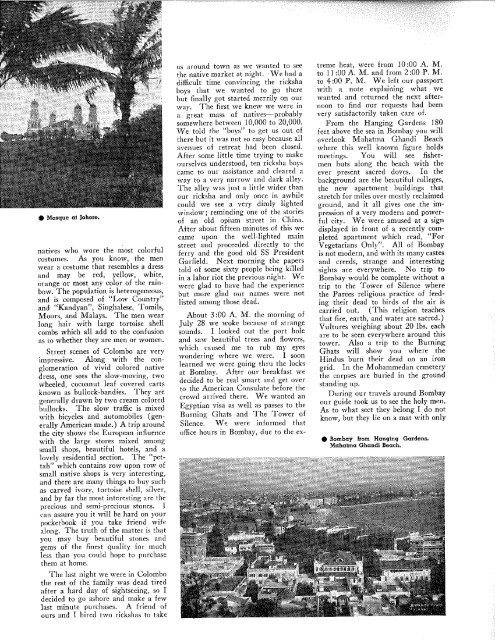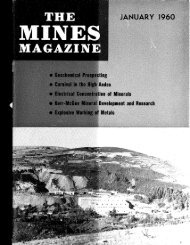M A R C H 1 9 4 0 ^ ^ ^ V O L U M E 30 No. 3 - Mines Magazine
M A R C H 1 9 4 0 ^ ^ ^ V O L U M E 30 No. 3 - Mines Magazine
M A R C H 1 9 4 0 ^ ^ ^ V O L U M E 30 No. 3 - Mines Magazine
You also want an ePaper? Increase the reach of your titles
YUMPU automatically turns print PDFs into web optimized ePapers that Google loves.
for March, 1940<br />
• Mosque ol lohore.<br />
natives Avho wore the most colorful<br />
costumes. As you know, the men<br />
wear a costume that resembles a dress<br />
and may be red, 3'eUow, white,<br />
orange or most any color of the rainbow.<br />
The population is heterogeneous,<br />
and is composed of "Low Country"<br />
and "Kandyan", Singhalese, Tomils,<br />
Moors, and Malays. The men Avear<br />
long hair with large tortoise shell<br />
combs which all add tn the confusion<br />
as to whether they are men or women.<br />
Street scenes of Colombo are very<br />
impressive. Along with the conglomeration<br />
of vivid colored native<br />
dress, one sees the slow-moving, two<br />
wheeled, cocoanut leaf covered carts<br />
known as bullock-bandies. They are<br />
generally drawn by two cream colored<br />
bullocks. The slow traffic is mixed<br />
with bicycles and automobiles (generally<br />
American made.) A trip around<br />
the city shows the European influence<br />
with the large stores mixed among<br />
small shops, beautiful hotels, and a<br />
lovely residential section. The "pettah"<br />
which contains row upon row of<br />
small native shops is very interesting,<br />
and there are many things to buy such<br />
as carved ivory, tortoise shell, silver,<br />
and by far the most interesting are the<br />
precious and semi-precious stones. 1<br />
can assure you it will be hard on your<br />
pocketbook if you take friend wife<br />
along. The truth of the matter is that<br />
you may buy beautiful stones and<br />
gems of the finest quality for much<br />
less than you could hope to purchase<br />
them at home.<br />
The last night we were in Colombo<br />
the rest of the family was dead tired<br />
after a hard day of sightseeing, so I<br />
decided to go ashore and make a few<br />
last minute purchases. A friend of<br />
ours and I hired two rickshas to take<br />
us around town as we wanted to sec<br />
the native market at night. We had a<br />
difficult time convincing the ricksha<br />
boj's that we wanted to go there<br />
but finally got started merrily on our<br />
way. The first we knew we were in<br />
a great mass of natives—probably<br />
somewhere between 10,000 to 20,000.<br />
We told the "boys" to get us out of<br />
there but it was not so easy because all<br />
avenues of retreat had been closed.<br />
After some little time trying to make<br />
ourselves understood, ten ricksha boys<br />
came to our assistance and cleared a<br />
way to a very narrow and dark alley.<br />
The alley was just a little wider than<br />
our ricksha and only once in awhile<br />
could we see a very dimly lighted<br />
window; reminding one of the stories<br />
of an old opium street in China.<br />
After about fifteen minutes of this we<br />
came upon the well-lighted main<br />
street and proceeded directly to the<br />
ferry and the good old SS President<br />
Garfield. Next morning the papers<br />
told of some sixty people being killed<br />
in a labor riot the previous night. We<br />
were glad to have had the experience<br />
hut more glad our names were not<br />
listed among those dead.<br />
About 3:00 A. M. the morning of<br />
July 28 we woke because of strange<br />
sounds. I looked out the port hole<br />
and saw beautiful trees and flowers,<br />
which caused me to rub my eyes<br />
wondering where wc were. I soon<br />
learned we were going thru the locks<br />
at Bombay. After our breakfast we<br />
decided to be real smart and get over<br />
to the American Consulate before the<br />
crowd arrived there. We wanted an<br />
Egyptian visa as well as passes to the<br />
Burning Ghats and The Tower of<br />
Silence. We were informed that<br />
office hours in Bombay, due to the cxtreme<br />
heat, were from 10:00 A. M.<br />
to 11:00 A. M. and from 2:00 P. M.<br />
to 4:00 P. M. We left our passport<br />
with a note explaining what we<br />
wanted and returned the next afternoon<br />
to find our requests had been<br />
very satisfactorily taken care of.<br />
From the Hanging Gardens 180<br />
feet above the sea in Bombay j'Ou will<br />
overlook Mahatma Ghandi Beach<br />
where this well known figure holds<br />
meetings. You will see fishermen<br />
huts along the beach with the<br />
ever present sacred doves. In the<br />
background are the beautiful colleges,<br />
the new apartment buildings that<br />
stretch for miles over mostly reclaimed<br />
ground, and it ail gives one the impression<br />
of a verj' modern and powerful<br />
city. We were amused at a sign<br />
displayed in front of a recently completed<br />
apartment which read, "For<br />
Vegetarians Only". All of Bombay<br />
is not modern, and with its many castes<br />
and creeds, strange and interesting<br />
sights are everywhere. <strong>No</strong> trip to<br />
Bombay would he complete without a<br />
trip to the Tower of Silence where<br />
the Parees religious practice of feeding<br />
their dead to birds of the air is<br />
carried out. (This religion teaches<br />
that fire, earth, and water are sacred.)<br />
Vultures weighing about 20 lbs. each<br />
are to be seen everywhere around this^<br />
tower. Also a trip to the Burning<br />
Ghats will show you where the<br />
Hindus burn their dead on an iron<br />
grid. In the Mohammedan cemetery<br />
the corpses are buried in the ground<br />
standing up.<br />
During our travels around Bombay<br />
our guide took us to see the holy men.<br />
As to what sect they belong I do not<br />
know, but they lie on a mat with only<br />
# Bombay from Hanging Gardens.<br />
Mahalma Ghandi Beach.<br />
a small loin cloth on and cover their<br />
bodies with ashes. They will pray for<br />
those who come to them for aid. One<br />
of these holy men was supposed to be<br />
108 years old. A street scene in the<br />
native quarters is an ever changing<br />
one of vivid colors. Some of the<br />
women are veiled, while still others<br />
wear large nose rings. Ox carts are<br />
seen everywhere as well as the victoria—^generally<br />
drawn by worn out<br />
horses. The oriental smell and dirt<br />
is ever present in this section of the<br />
city.<br />
An hour in tlie Prince of Wales<br />
Museum will be worth the time spent<br />
there. You will see modern and<br />
antique silver, china, glassware. There<br />
are many beautiful paintings. We<br />
noted a picture of Abraham Lincoln.<br />
There are many shops in Bombay,<br />
most of the smaller ones are dirty<br />
with hundreds of dirty people milling<br />
around. The large meat market<br />
seemed fairly clean, the silk market<br />
was very extensive but we did not<br />
stop. When we got into the silver,<br />
gold, cotton, and foreign exchange 1<br />
thought we were in a riot with<br />
hundreds of men hollering everywhere,<br />
but our guide explained it was<br />
just the wealthy ^brokers at work. We<br />
drove thru the streets one night and<br />
found poor souls sleeping by the<br />
thousands on the side walks, on the<br />
ledges of windows, just anywhere<br />
there was a place to lie down.<br />
Books may be written about interesting<br />
things in Bombay but we must<br />
go on with the story, so we leave Bomhay<br />
for Suez.<br />
The ten-day trip from Bombay to<br />
Suez proved to be one of many cocktail<br />
parties and general good times<br />
aboard ship. Part of the time the<br />
Indian Ocean was very rough, but<br />
after we got into the Red Sea the<br />
water was smoother; however, it was<br />
very hot. An Australian friend of<br />
mine once told me the reason for giving<br />
the Red Sea that name was because<br />
it was so "bloody hot", and I know<br />
that is about right. One afternoon<br />
about 4 o'clock I was standing on the<br />
deck and noticed a very dark cloud<br />
ahead. In only a few minutes the<br />
air was fuil of sand and you could<br />
not see anything without the lights,<br />
and it lasted about three hours. , It<br />
gave one a peculiar feeling to be in a<br />
sand storm at sea.<br />
We arrived in Suez about 9:<strong>30</strong><br />
P. M. and hefore we cleared customs,<br />
immigration and quarantine it was<br />
well after 11:00 P. M. We tried to<br />
hire a car to take us across the desert<br />
to Cairo and ran into the worst<br />
oriental cunning and salesmanship<br />
# Dobi Ghats. All washing of Bombay is done in these Ghats.<br />
•f—*<br />
# Gateway to India. From Bombay.<br />
# Prince of Wales Museum, Bombay.

















